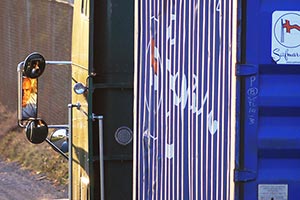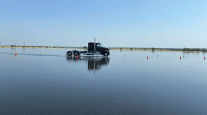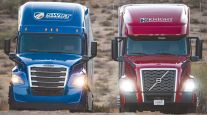California’s Truckers Dream of Dedicated Truck Lanes

Trish Anderson, 53, a truck driver from Mississippi, dreams about dedicated truck lanes. A lot.
“Dedicated truck lanes that are only for trucks should be everywhere. Seriously, that’s the first thing I think of and that should be everywhere, not just even because the ports are going to be congested,” she said while resting at an Ontario truck stop.
“It would make it easier because you don’t have to deal with all the cars. If it’s all trucks, and everyone’s in the same mindset, you don’t have to dodge traffic.”
She’s not the only one dreaming.
With goods movement from the ports of Los Angeles and Long Beach expected to double in the next decade, logistics industry experts are looking at ways to address an expected tsunami of freight through the region’s already congested freeways and streets.
Among infrastructure improvement ideas applauded by local truckers rolling through the Inland Empire are efforts by transportation officials to widen the freeways and fix potholes and a proposal to introduce dedicated truck lanes.
With population and traffic in the Inland Empire expected to grow in the coming years, local officials have been developing plans for new toll lanes, wider freeways, safer on- and off-ramps and more rail transit opportunities – some of which are under construction.
Twenty-year traffic forecasts, according to an informational post on the San Bernardino Associated Governments website, indicate that several Southern California freeways, including Route 60 and Interstate 15 in San Bernardino County, will experience increases in truck volumes so great, they’ll take up the roadways’ entire capacity.
Dedicated truck toll lanes have been proposed by Southern California transportation officials, but to build them, according to the SANBAG’s online post, the public cost is likely to exceed $5 billion, of which at least $1.2 billion would be for truck lanes within San Bernardino County.
In Riverside County, $500 million in funding has been invested toward goods movement-related rail grade separation projects. The Riverside County Transportation Commission has proposed tolled express lanes through I-15 to relieve congestion. The project has an estimated cost range of $425 million to $450 million.
Recently, dozens of truck drivers were resting in their cabs parked at the TravelCenters of America truck stop in Ontario, California, some having spent hours just to get from the ports of Los Angeles and Long Beach to the Inland Empire.
Renee Miri, 60, a truck driver from Michigan, said truckers wouldn’t mind paying tolls for a dedicated truck lane.
“Dedicated truck lanes would be great if you had two lanes where you could pass other trucks because trucks always want to pass,” Miri said. “Trucks would probably pay tolls because sometimes it takes us five hours to get out of Los Angeles to Barstow when we pick up in L.A. That’s just nuts.”
Larry Little, 72, a truck driver from Georgia, said the deteriorating roads in Southern California are in need of improvement.
“They’re going to have to raise the fuel tax or something to do some road repairs because the roads are getting deplorable,” Little said.
Transportation California, an industry-based advocacy group in Sacramento, has been pushing for additional investment for infrastructure expansion to address increased traffic in coming years.
“We’re not advocating for specific improvements other than additional capacity to help meet freight demands,” said Will Kempton, executive director of Transportation California and a former director of Caltrans. “Our program is concerned about the conditions of the roadway, and there are suggestions about dedicated truck lanes in terms of toll operations to allow for that.”
As part of efforts to alleviate congestion, John Husing, chief economist for the Inland Empire Economic Partnership and an expert on regional goods movement, was commissioned by the Port of Long Beach with the cooperation of the Port of Los Angeles to complete an economic analysis of an “Inland Port” served by a dedicated train.
The idea involves a train bringing unsorted Inland Empire-bound goods to a facility in the region to be sorted and delivered to local warehouses. Husing said implementing the idea would significantly cut truck traffic from the ports to the Inland Empire.
“Imagine taking most of the trucks off the 10 and the 60 between here and the 710 freeway and the harbors,” Husing said. “In the trucking industry, the key word is turns, so instead of having a truck do at the most a couple of (trips) a day, it can do three to five turns a day, because they’re not stuck in L.A. traffic and they’re not stuck at the gates.”




